Research
Reserach of the of the working group nutrition in prevention and therapy.
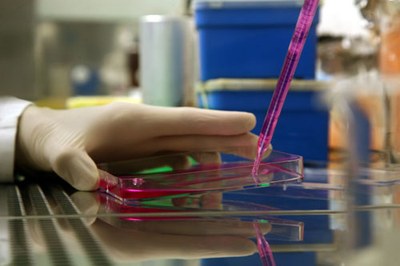
Reserach Goals
Our research focusses on mitochondria the main source of cellular energy:
- Role of mitochondria in aging. Mitochondria provide the cells with energy and are involved in apoptotic processes.
- Impact of mitochondria for nutrition- and age related diseases
- Role of the mevalonate pathway in aging. The mevalonate pathway provides the cell with indispensable lipids including cholesterol, isoprenoids, and neurosteroids.
- Nutritional approaches for the prevention and therapy of nutrition- and age related diseases.
Background: Mitochondrial Dysfunction in Aging and Neurodegeneration
Mitochondrial function.
Cell organelles playing a major role in aging are mitochondria, due to their central role in energy supply, as major source of oxidative stress, and as critical regulators of apoptosis. During evolution, the brain developed specific mechanisms to compensate oxidative stress, which could be specifically activated by nutrients, such as polyunsaturated fatty acids, Mediterranean plant and berry extracts as well as isolated secondary plant compounds, such as hydroxytyrosol, or curcumin.
Mitochondria – key organelles for energy supply and cell death
Increasing evidence suggests that mitochondrial dysfunction plays an important role not only in brain aging but also in the pathogenesis of neurodegenerative diseases including AD. Mitochondria are complex, network forming organelles, involved in different metabolic pathways, e.g. citric acid cycle (TCA), energy transformation, amino acid metabolism and urea cycle. Mitochondria consist of inner and outer membranes composed of phospholipid bilayers and proteins. The inner mitochondrial membrane harbors the proteins of the electron transfer system (ETS), responsible for oxidative phosphorylation. The mitochondrial oxidative phosphorylation (OXPHOS) system is the final biochemical pathway producing energy in form of ATP by consuming oxygen. Electrons are transferred through the complexes of the mitochondrial respiration chain and simultaneously, an electrochemical proton gradient is build across the inner mitochondrial membrane generating the proton-motive force the production of ATP.
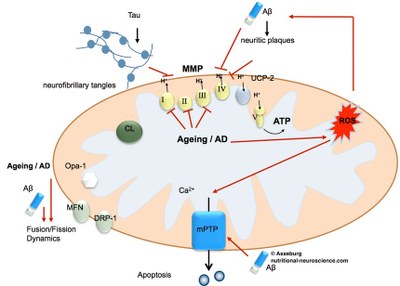
Alterations of mitochondrial efficiency and function are mainly related to alterations in mitochondrial mass, amount of respiratory enzymes or changes in enzyme activities. A reduction in mitochondrial content or lowered ETS results in a general limitation of cellular energy production. Dysfunction of single complexes of the respiratory system are frequently accompanied by deleterious side effects, such as loss of mitochondrial membrane potential (MMP) and subsequently decreased ATP levels, but also production of reactive oxygen species (ROS).
Beside enzymatically produced ROS by NADPH oxidases, cytochrome P450-dependent oxygenases, and xanthine dehydrogenases, mitochondria are regarded as the primary site of ROS production within cells. The ETS constantly generates low physiological levels of ROS, which trigger various defense mechanisms, i.e anti-oxidative molecules (e.g. glutathione or vitamin E) and antioxidant enzymes (e.g. superoxide dismutase (SOD), catalase, glutathione peroxidase and glutathione reductase). Furthermore, slight uncoupling of the ETC, for instance by uncoupling proteins, is one possibility to achieve a reduction in ROS production. Functional failure of this system can lead to deleterious effects, which might exaggerate consequence of mitochondrial dysfunction. Mitochondria are often considered as both the initiator and the first target of oxidative stress. Insufficient defense mechanisms and excessive ROS production (e.g as superoxide anions) can lead to cell damage. The major sources of superoxide anions are redox centers of complex I and III of the ETS and different mitochondrial flavoproteins. Superoxide is a rather weak radical, but it is the precursor of various, potentially more toxic ROS. Its transformation into hydrogen peroxide, hydroxyl radicals as well as its participation in the formation of peroxynitrate creates strong oxidants.
Proteins of the OXPHOS system and lipids are key targets of the deleterious effects of ROS and might lead to membrane depolarization and subsequently impaired mitochondrial function. For example, oxidative damage of omega-3 polyunsaturated fatty acids (PUFA) in the inner mitochondrial membrane has been shown to result in loss of MMP, representing one early hallmark of apoptosis. Mitochondria act as signal-integrating organelles in the on-set of the intrinsic apoptotic pathway. Mitochondrial outer membrane permeabilization and permeability transition result both in the release of pro-apoptotic proteins which in turn activate caspases and further down-stream cell death mechanisms.
Dysfunction of single mitochondrial enzyme complexes, ROS production, mitochondrial permeability transition pore opening (mPTP), elevated apoptosis, but also structural alterations and a diminished mitochondrial content play a role in brain aging and are believed to be crucial for the onset and progression of neurodegenerative diseases.
Current Projects
Polyphenols, its Metabolites and other biofunctional Food Ingredients - Role in Brain Aging and Neurodegeneration
GOAL: How do polyphenols and its metabolites deriving from gut microbiota interact with mitochondria in models of brain aging and neurodegeneration..
In this project wie investigate different substances including polyphenols and its metabolites such as Urolithin A deriving from gut microbiota in relation to mitochondrial dysfunction in brain aging and neurodegeneration. In this context, hesperetin, alpha-lipoid acid, and silibinin were investigated also. Furthermore, biofactors including vitamines and minerals were investigated and, most recently, the coffee ingredients caffeine, cafestol and kahweol are being investigated within the framework of this project. Model organisms used include mice, nematodes, and neuronal cells.
Conducted by: Fabian Schmitt, Fabian Dieter, Dr. Martina Reutzel, Dr. Carsten Esselun, and Dr. Benjamin Dilberger
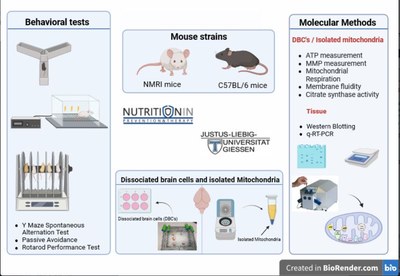
Related Publications
Rajha HN, Paule A, Aragonès G, Barbosa M, Caddeo C, Debs E, Dinkova R, Eckert
GP, Fontana A, Gebrayel P, Maroun RG, Napolitano A, Panzella L, Pasinetti GM,
Stevens JF, Schieber A, Edeas M. Recent Advances in Research on Polyphenols:
Effects on Microbiota, Metabolism, and Health. Mol Nutr Food Res. 2022; 66(1):e2100670.
Schmitt F, Babylon L, Dieter F, Eckert GP. Effects of Pesticides on Longevity
and Bioenergetics in Invertebrates-The Impact of Polyphenolic Metabolites. Int J
Mol Sci. 2021;22(24):13478.
Babylon L, Schmitt F, Franke Y, Hubert T, Eckert GP. Effects of Combining
Biofactors on Bioenergetic Parameters, Aβ Levels and Survival in Alzheimer Model
Organisms. Int J Mol Sci. 2022 Aug 4;23(15):8670.
Dieter F, Esselun C, Eckert GP. Redox Active α-Lipoic Acid Differentially
Improves Mitochondrial Dysfunction in a Cellular Model of Alzheimer and Its
Control Cells. Int J Mol Sci. 2022; 23(16):9186.
Reutzel M, Grewal R, Joppe A, Eckert GP. Age-Dependent Alterations of
Cognition, Mitochondrial Function, and Beta-Amyloid Deposition in a Murine Model
of Alzheimer's Disease-A Longitudinal Study. Front Aging Neurosci. 2022; 14:875989.
Babylon L, Grewal R, Stahr PL, Eckert RW, Keck CM, Eckert GP. Hesperetin
Nanocrystals Improve Mitochondrial Function in a Cell Model of Early Alzheimer
Disease. Antioxidants (Basel). 2021 Jun 23;10(7):1003.
Dilberger B, Weppler S, Eckert GP. Phenolic acid metabolites of polyphenols
act as inductors for hormesis in C. elegans. Mech Ageing Dev. 2021; 198:111518.
Esselun C, Bruns B, Hagl S, Grewal R, Eckert GP. Impact of Silibinin A on
Bioenergetics in PC12APP<sub>sw</sub> Cells and Mitochondrial Membrane
Properties in Murine Brain Mitochondria. Antioxidants (Basel). 2021; 10(10):1520.
Esselun C, Theyssen E, Eckert GP. Effects of Urolithin A on Mitochondrial
Parameters in a Cellular Model of Early Alzheimer Disease. Int J Mol Sci. 2021; 22(15):8333.
Dilberger B, Passon M, Asseburg H, Silaidos CV, Schmitt F, Schmiedl T,
Schieber A, Eckert GP. Polyphenols and Metabolites Enhance Survival in Rodents
and Nematodes-Impact of Mitochondria. Nutrients. 2019; 11(8):1886.
Bioavailability and functionality of carotenoids from orange juice
GOAL: Improving the bioavailability of carotenoids from orange juice through innovative homogenisation strategies and investigate its neuroprotective properties. Studies of metabolised orange juice and its carotenoids on bioenergetic parameters in human peripheral blood cells.
A joint project of the Professorship of Molecular Food Technology at the Institute of Nutrition and Food Science at the University of Bonn and the Professorship of Nutrition in Prevention and Therapy at the Institute of Nutrition Science at the University of Giessen. Sponsored by the Forschungskreis der Ernährungsindustrie e.V. (FEI) and the German Federal Ministry of Economics and Climate Protection (BMWK). #AiF 22262 N
Conducted by Alice Quentin.
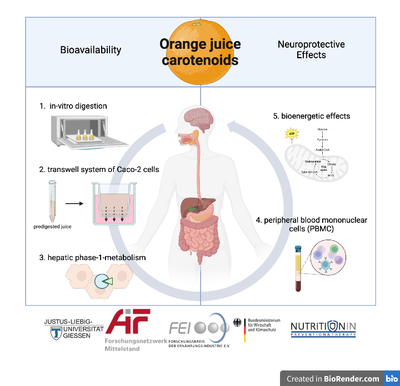
NEWS:
Kick-off meeting in Bonn (11/02/22):

From left: Julia Klotz (Bonn), Alice Quentin (Gießen), Fabian Weber (Bonn), Andreas Schieber (Bonn), Gunter Eckert (Gießen).
ADF/cofilin in the nematode Caenorhabditis elegans – The Impact for mitochondrial dysfunction in Alzheimer`s disease
Goal: The aim of the project is the understanding about activation of ADF/cofilin (homologue UNC-60) in the nematode Caenorhabditis elegans. Focussing on mitochondria as a major target I would like to connect the appearance of aggregated amyloid beta with cofilin/actin rods and mitochondrial dysfunction.
Conducted by Fabian Schmitt.
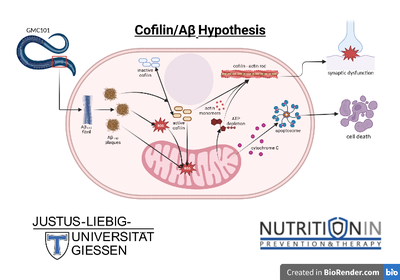
Peripheral Blood Cells as a Model of Mitochondrial Function
Goal: Peripheral Blood Mononuclear Cells (PBMCs) as a suitable surrogate marker for mitochondrial function which are easily accessible and can be stored for a longer period of time are a promising component in human studies. PBMCs and platelets offer a minimally invasive way to study mitochondrial function and bioenergetics. To make this independent of time and place of measurement, we want to establish a method that that allows measurements of mitochondrial function after cryopreservation of PBMCs over 6 months of time.
Conducted by Fabian Dieter, and Dr. Carmina Silaidos
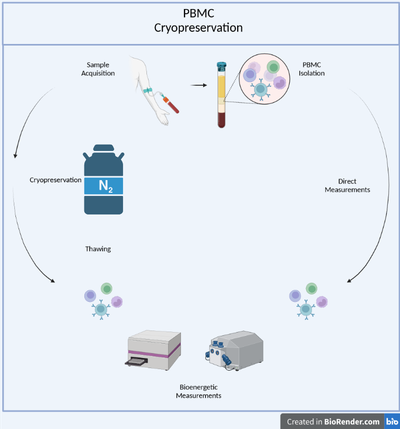
Omega-3 fatty acids in aging and neurodegeneration
Goal: To investigate the role of polyunsaturated fatty acids (PUFA) in brain aging and pathomechanisms leading to Alzheimer's disease. Special focus on neuronal membranes and mitochondria.
Conducted by Dr. Carsten Esselun, Dr. Dirk Berressem, and Dr. Sarah Ötzkan (Asfordel)
Related Publications
Esselun C, Dieter F, Sus N, Frank J, Eckert GP. Walnut Oil Reduces Aβ Levels
and Increases Neurite Length in a Cellular Model of Early Alzheimer Disease.
Nutrients. 2022; 14(9):1694.
Frank J, Kisters K, Stirban OA, Obeid R, Lorkowski S, Wallert M, Egert S,
Podszun MC, Eckert GP, Pettersen JA, Venturelli S, Classen HG, Golombek J. The
role of biofactors in the prevention and treatment of age-related diseases.
Biofactors. 2021; 47(4):522-550.
Esselun C, Dilberger B, Silaidos CV, Koch E, Schebb NH, Eckert GP. A Walnut
Diet in Combination with Enriched Environment Improves Cognitive Function and
Affects Lipid Metabolites in Brain and Liver of Aged NMRI Mice. Neuromolecular
Med. 2021; 23(1):140-160. doi: 10.1007/s12017-020-08639-7. Epub 2020 Dec 26.
PMID: 33367957; PMCID: PMC7929966.
Kutzner L, Esselun C, Franke N, Schoenfeld K, Eckert GP, Schebb NH. Effect of
dietary EPA and DHA on murine blood and liver fatty acid profile and liver
oxylipin pattern depending on high and low dietary n6-PUFA. Food Funct. 2020; 11(10):9177-9191. doi: 10.1039/d0fo01462a. PMID: 33030169.
Ostermann AI, Reutzel M, Hartung N, Franke N, Kutzner L, Schoenfeld K,
Weylandt KH, Eckert GP, Schebb NH. A diet rich in omega-3 fatty acids enhances
expression of soluble epoxide hydrolase in murine brain. Prostaglandins Other
Lipid Mediat. 2017; 133:79-87.
Berressem D, Koch K, Franke N, Klein J, Eckert GP. Intravenous Treatment with
a Long-Chain Omega-3 Lipid Emulsion Provides Neuroprotection in a Murine Model
of Ischemic Stroke - A Pilot Study. PLoS One. 2016; 11(11):e0167329.
Afshordel S, Hagl S, Werner D, Röhner N, Kögel D, Bazan NG, Eckert GP.
Omega-3 polyunsaturated fatty acids improve mitochondrial dysfunction in brain
aging--impact of Bcl-2 and NPD-1 like metabolites. Prostaglandins Leukot Essent
Fatty Acids. 2015; 92:23-31.
Eckert GP, Lipka U, Muller WE. Omega-3 fatty acids in neurodegenerative
diseases: focus on mitochondria. Prostaglandins Leukot Essent Fatty Acids. 2013; 88(1):105-14.
Fungi against Alzheimer's Disease
Goal: The fungi Hericium erinaceus and its secondary metabolite Erinacine C will be tested in cellular and invertebrate models of Alzheimers disease.
Hericium erinaceus is a kind of metabolic syndrome regulator and tonic drug in Chinese Medicine. Fungi of the class of basidiomycetes are known to form a broad spectrum of biologically active secondary metabolites, especially low molecular weight terpenoids. Erinacines, seldom cyathane type diterpenoids, are produced in submerged grown mycelia and fruiting bodies of Hericium erinaceus. Erinacines have been reported to promote nerve growth factor (NGF) synthesis, which suggests the application of H. erinaceus or secondary metabolites derived thereof for the treatment and prevention of dementia and further neural degenerative diseases. H. erinaceus is part of the traditional Chinese Medicine and has and has proved efficacy in models of Alzheimer`s disease and in a human trial to delay cognitive decline in the elderly.
A joint project of the Institute of Food Chemistry and Food Biotechnology (Holger Zorn) the Institute of Nutrition Science (Gunter Eckert) at the University of Giessen. Sponsored by the Horst Görtz Foundation.
Conducted by Bernhard Hellmann.
Cholesterol, Isoprenoids and Protein Prenylation in Brain Aging and Neurodegeneration
Goal: Beside cholesterol the mevalonate pathway provides cells with the isoprenoids farnesyl- and geranylgeranyl-pyrophosphate (FFP and GGPP). FFP and GGPP are essential for the isoprenylation and thus activation of Rho proteins. The project aims to explore the role of cholesterol, isoprenoids, and protein isoprenylation in brain aging and neurodegeneration.
The mevalonate- (MVA-) pathway is a crucial metabolic pathway for most eukaryotic cells, with cholesterol as its most recognized product. Cholesterol represents a strucural component of neuronal membranes.
Cholesterol is also a precursor for neurosteroids which are produced in mitochondria after active import into the organell. Neurosteroidsynthesis links the mevalonate pathway to mitochondrial function.
The mevalonate pathway also provides the cell with isoprenoids - another class of indispensable lipids. The short-chain isoprenoids farnesylpyrophosphate (FPP) and geranylgeranylpyrophosphate (GGPP) covalently attach to small GTPases, which act as molecular switches in various biochemical pathway.
Synaptic dysfunction reprents another common hallmark of brain aging and neurodegenerative diseases. The Rho family of small GTPases are one of the major regulators in synaptic plasticity, both in dendrite morphogenesis and stability as well as in growth cone motility. Prenylation is a requirement for their correct funtion.
A tentative conclusion our recent results is that the regulation of isoprenoids is altered in brain aging and AD and such changes may alter protein prenylation and contribute to AD neuropathophysiology. Our latest un-published data indeed strongly indicate that Rho GPTases are mislocolized in brain ageing and neurodegeneration.
Conducted by Dr. Sarah Ötzkan (Afshordel) and Dr. Gero Hooff.
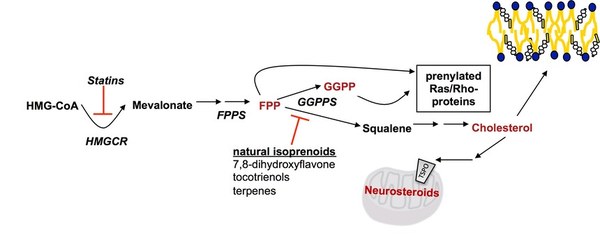
Related Publications
Ötzkan S, Muller WE, Gibson Wood W, Eckert GP. Effects of
7,8-Dihydroxyflavone on Lipid Isoprenoid and Rho Protein Levels in Brains of
Aged C57BL/6 Mice. Neuromolecular Med. 2021 Mar;23(1):130-139. doi:
10.1007/s12017-020-08640-0. Epub 2020 Dec 30. PMID: 33377988; PMCID: PMC7929957.
Marschalek N, Albert F, Afshordel S, Meske V, Eckert GP, Ohm TG.
Geranylgeranyl pyrophosphate is crucial for neuronal survival but has no special
role in Purkinje cell degeneration in Niemann Pick type C1 disease. J Neurochem.
2015 Apr;133(1):153-61.
Afshordel S, Kern B, Clasohm J, König H, Priester M, Weissenberger J, Kögel
D, Eckert GP. Lovastatin and perillyl alcohol inhibit glioma cell invasion,
migration, and proliferation--impact of Ras-/Rho-prenylation. Pharmacol Res.
2015 Jan;91:69-77.
Afshordel S, Wood WG, Igbavboa U, Muller WE, Eckert GP. Impaired
geranylgeranyltransferase-I regulation reduces membrane-associated Rho protein
levels in aged mouse brain. J Neurochem. 2014 May;129(4):732-42.
Posada-Duque RA, Velasquez-Carvajal D, Eckert GP, Cardona-Gomez GP.
Atorvastatin requires geranylgeranyl transferase-I and Rac1 activation to exert
neuronal protection and induce plasticity. Neurochem Int. 2013 Mar;62(4):433-45.
Hooff GP, Wood WG, Kim JH, Igbavboa U, Ong WY, Muller WE, Eckert GP. Brain
isoprenoids farnesyl pyrophosphate and geranylgeranyl pyrophosphate are
increased in aged mice. Mol Neurobiol. 2012 Aug;46(1):179-85.
Hooff GP, Wood WG, Müller WE, Eckert GP. Isoprenoids, small GTPases and
Alzheimer's disease. Biochim Biophys Acta. 2010 Aug;1801(8):896-905.
Hooff GP, Peters I, Wood WG, Müller WE, Eckert GP. Modulation of cholesterol,
farnesylpyrophosphate, and geranylgeranylpyrophosphate in neuroblastoma SH-
SY5Y-APP695 cells: impact on amyloid beta-protein production. Mol Neurobiol.
2010 Jun;41(2-3):341-50.
Eckert GP, Hooff GP, Strandjord DM, Igbavboa U, Volmer DA, Müller WE, Wood
WG. Regulation of the brain isoprenoids farnesyl- and geranylgeranylpyrophosphate is altered in male Alzheimer patients. Neurobiol Dis. 2009 Aug;35(2):251-7.

